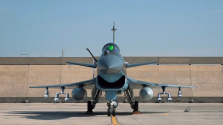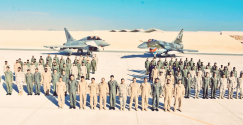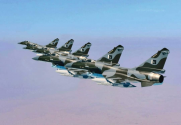[...]
The fleet in my view should have been two thirds J-10’s and one third being J-16’s and J-20’s. But China lacks long range strike platforms and the H-6 is showing its age so China has to compensate with Flankers.
There are several problems with this message. [...]
The reason why NATO air forces have the current fleet composition of single/twin and light/heavy fighters is different. It is the consequence of the history of jet engine technology development which in turn was determined at a key divergence point by available technology of propulsion and weaponry which informed doctrine and tactics. Those result in aircraft design which is chosen at a specific point in time but which is supposed to last 25 years at minimum and that often means that in the long term what was optimal at the moment of decision is a burden later.
US introduced afterburning turbofans to their heavy fighters in the 1960/70s: F-111, F-14 and F-15. F-111 was developed in a joint USAF-USN program where USAF adopted the tactical bomber F-111A variant while Navy rejected F-111B in favour of F-14A. USAF developed F-15 as heavy fighter.
The engines were implemented in F-16 program as economies of scale generated savings despite higher cost of the engine.
USSR followed suit with RD-33 and AL-31 in the 1970/80s but due to less developed technological base and differences in doctrine (distinction between "frontline" VKS and "air defence" PVO aviation and resulting roles) they developed a low-performance turbofan for frontline light fighter MiG-29 for VKS only and high-performance turbofan for universal heavy fighter Su-27 for both VKS and PVO. Similar technological issues caused the divergence in radar development with MiG-29 receiving a below-specs radar because Soviet technology couldn't fit required specs in the nose.
France designed engines for their light Mirage fighters so they were forced to follow a similar evolution as Klimov. Britain had technology but never implemented it at scale which is why EJ-2000 made by Rolls-Royce is between French and US engines. Consequently
in 1990s only US and Russia had engines for heavy fighters.
However:
F-16 was developed to counter Soviet numbers when SARH missiles were standard BVR munition. SARH is strongly dependent on engine power because it determines ceiling, velocity and radar power all of which are necessary to give sufficient advantage for safe charging at enemy with SARH missile.
ARH missiles change the dynamic of air-to-air encounter entirely compared to SARH: ceiling, velocity and radar power are not as relevant. This meant that F-16 armed with AIM-120A suddenly became viable as an air-superiority fighter, and would beat F-15s armed with AIM-7M. At the same time
in Desert Storm F-16 was the most effective and efficient tactical bomber winning against F-15E, F-111 etc which meant that what initially was a supplementary economy fighter became the main fighter.
Also improvements to electronics meant that missiles would play a larger role in the future because the development in the field was only starting, while engines already were encountering hard limits which was only verified in F-22 program leading to F-35 being what it is.
Finally Cold War ended 15 years (10 for Europe) into new generation of engines and no viable threat emerged until 2020s. That meant that the equivalent of funding that took engines from first turbojets in early 40s to first turbofans in early 70s was denied for the subsequent generation and all (except the US) NATO countries were stuck with their 4gen designs due to budget cuts.
Where NATO fleets were left in 1991 that's where they are today. It's not a consequece of a tactical decision. It's a consequence of a budget decision.
Russia chose Su-27 and AL-31 over MiG-29 and RD-33 because MiG-29 was Soviet F-16 except without Soviet AMRAAM and Soviet AN/APG-68 so it lacked the only things that could make it viable vs Su-27 and Su-34.
China is also driven more by technology than by doctrine. J-16, J-15, J-11 and Su-27, Su-30 and Su-35 are benefiting from economies of scale indirectly (weapons, training, tactics, maintenance) and that is a process started in the 1990s when J-10 wasn't available while Flanker technology was entering a second generation.
J-20 is the only twin-engine fighter that was chosen as such due to its role and J-20s intended engine only recently entered production. So it's less about parameters of the aircraft and more what was most effective at any given moment. Greater range is not the decisive parameter because buying plenty of Il-76s converted to tankers was never a problem.
Also all things considered USAF had to cut cost because it was already very big and very expensive for three decades and
existing personnel and structure were the drivers behind the decisions. Two engines are costly because of twice the workload. PLAAF is only now moving into that position so technology still gives benefits and people are not yet the burden.
PAF is so confident in this bird. First against F-15 SA/F-16C/D and now against Rafale and Eurofighter…
It's not confidence. That's the second reason why PAF got J-10C - to gather and send information in a controlled manner. It's also an opportunity to market a cheap fighter. For some countries JF-17 is the natural choice. For others it's J-10C. The idea that it's some type of demonstration or real test of combat capabilities is misguided. Apart from Rafale those are not its intended opponents.
The primary reason for J-10C in PAF is better integration with PLAAF on a systemic level. JF-10 is in the same class as JF-17 and shares most weapons. It's everything else that matters: sustainment, training, basing etc. Once J-10 is introduced in PAF China can use their J-10 stock and support to give strategic depth to PAF's aerial attrition vs India.
RBE2 F3R uses holdover PESA software and doesn’t fully AESA while I’m sure the J-10 radar does.
This is a misconception arising from
online conversations on Russian radars.
Russia had this problem because their PESA radar architecture was still partly
analog,
developed in 70s for N007 and MiG-31 and digital architecture was introduced
incrementally over the course of N011 program in the 90/00s because this is sensitive technology so there is a limit at what components can be used and Russia exited the Cold War without a digital electronics industry to speak of. N035 is the first fully digital Russian phased array radar in regular service and it's
full of Chinese components because Russia simply doesn't have the industrial base and China is the only source of technology that is sanction-proof or COTS but secure enough.
Russia is good at fundamental science, but fails where it requires functioning commercial industry. This is why they're good at nuclear power, thermal rockets or submarines or ground based radars but fail where miniaturisation is a factor.
France doesn't have the same problem because they developed digital radars long before they had PESA and long before Russia had digital radars and in general France treats electronics as one of strategic industries so technology is maintained as national security goal even if it has no export markets and they managed to get their security exposure to a minimum.
RBE2-AA/AESA has been available for 10 years, and in development for 20, so the architecture already supports "fully AESA". Again this is an echo of what N035 is - a PESA array with an additional
single simultaneous beam for targeting and detection of VLO targets. It's not "fully AESA" but technically it is no longer PESA per definition hence the confusion and arguments. And since N035 is derived from N011 it shares certain limitations on architecture that e.g. N036 doesn't having been "fully digital AESA" from ground up.
In general a lot of the misinformation on military technology comes from Russian propaganda. That's
30 years of maintaining
rhetorics of parity while in reality Russia was consistently behind in terms of available technology. That stage is largely over thanks to cooperation with China but the conversations from the past influence the conversations now because ignorant people online are more interested in winning arguments rather than learning.



